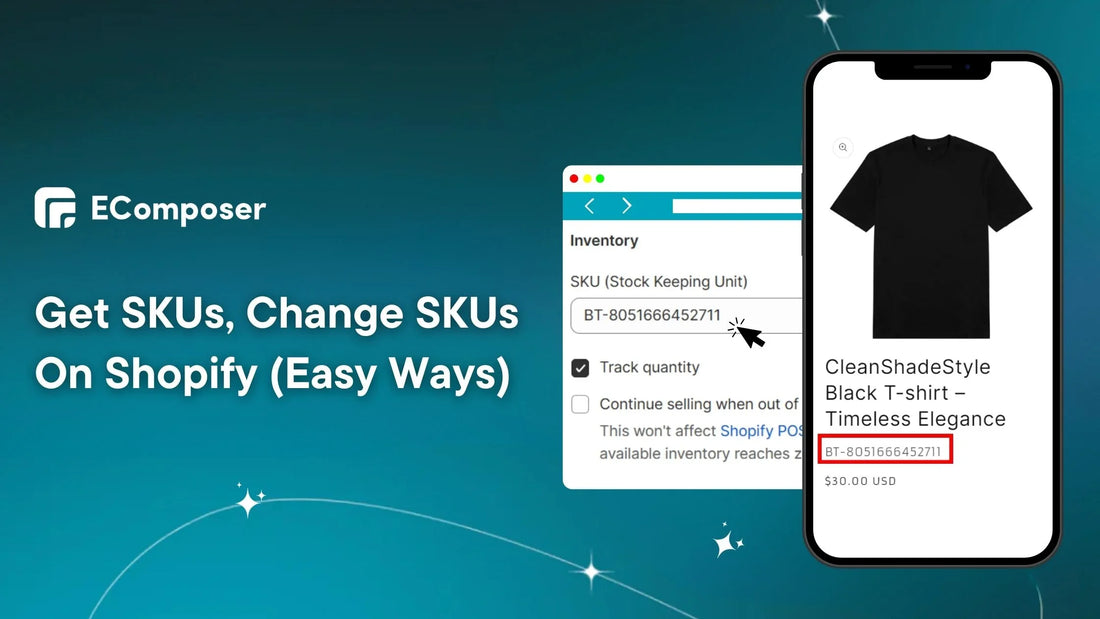How Do You Get SKUs, Change SKUs On Shopify? (Easy Ways)

Table Of Contents
Get and modify SKUs easily in your company to simplify organization and enhance customer experiences. Especially for a store with hundreds or thousands of items, having an SKU can simplify your stock inventories. Music Giant Swee Lee Manages is a fantastic example, with over 30,000 SKUs in-store and online via Shopify.
Successful online businesses start with SKUs, so read on to discover how to obtain and alter SKUs on Shopify effortlessly.
What Is SKUs Shopify?

Shopify SKUs are numbers and letters for webshop products. They identify online commerce products.
When listing products in a Shopify store, assigning unique SKUs simplifies inventory management, monitoring, and categorization.
Why Is SKU Management Important In Shopify?
At Shopify, SKU management is more than product identification—the key to online success. Robust SKU systems impact every area of your online business, from inventory to order fulfillment:
Seamless Order Fulfillment
Imagine an eager customer finding their goods out of stock. Improving SKU management dramatically reduces disappointments. Shopify simplifies order fulfillment by connecting SKUs to product variations. Shopify knows which item to send when a customer clicks 'Buy,' accelerating fulfillment.
Enhanced Organizational Efficiency

For online stores, SKU management guides them through inventories. It organizes a product labyrinth. A well-structured SKU system helps retailers find, classify, and categorize items, making inventory auditing, restocking, and workflow easier for merchants and consumers.
For example, Wayfair, a prominent online furniture and home goods shop, contains SKUs for its wide assortment of couches, chairs, tables, and home décor. To help customers choose, SKUs are presented with product descriptions.

(image source: wayfair.com)
Effect On SEO
SKUs are mostly utilized for internal inventory and order administration in Shopify. Hence, their impact on SEO may be indirect.
However, effective SKU management indirectly affects SEO in many ways:
- Product Organization: Well-structured SKUs help Shopify organize its product catalog. This organization may improve user experience and SEO by categorizing products and simplifying website navigation.
- Inventory Availability: Product availability and supply are ensured by accurate SKU management. This may improve user experience by helping buyers identify items, lowering bounce rates, and boosting time-on-site metrics, which can indirectly affect SEO.
- Data Insights: SKU management provides vital product, sales, and stock data. Through data-driven product and marketing optimization, Shopify shops may boost conversion rates and user engagement, improving SEO.
3 Steps To Add SKUs In Your Shopify Store
Adding SKUs to your product listings just takes three simple steps:
Step 1: Login & Product Section Access
First, sign in to your Shopify admin dashboard to get product SKUs.
Next, click "Products" to see a list of all the items in your store. This is usually on the left sidebar or main menu.

Then, you can see a list of your things in the "Products" part. For more details, click on a product you want to edit SKUs.

Step 2: Create & Edit SKUs Product
Editing An Existing Product
After step 1, you'll see edit products.
While working with an existing product, you may change its name, description, price, and photos using the editing tool. You may also change product availability, delivery choices, tags, and categories.
Then, you may change or create a product SKU in the "Inventory" section below.

For A New Products
To add a new product, go to the top right corner and click the "Add product" button.
Next, scroll down to the "Inventory" area to change or create a product SKU like the instructions above.
When you add a new product, you will be asked to enter information like the product's name, price, description, and pictures. Use accurate and appealing information to attract consumers.
Pro Tips: The live drag-and-drop editor in EComposer Page Builder makes creating any page type or section easy and fast. EComposer lets businesses easily construct a Landing, Homepage, Collection, Product, Blog, Cart, Footer, Coming Soon, 404 page, or any theme component.

Step 3: Save Your Products
Lastly, to save your changes, click the "Save" button in the upper right area of the screen.

Don't forget to click "Track quantity" for the SKU to track product inventory.
Also, you can choose to "Continue selling when out of stock" if you want to. This won't affect Shopify POS. Staff will get a warning but may sell when inventory is nil or less.
How Do You Show SKUs On Your Products Page’s Shopify?
Shopify product pages with SKUs give vital information to you and your consumers. Here are the basic steps to display SKUs with product data, improve inventory management, and help buyers make educated purchases:
1. Choose Editing Your Themes
First, go to the "Online Store" area of the admin dashboard and pick "Themes" from the drop-down menu.
Then you choose the "Customize" option.

Later, on the center page, choose "Products" to update your theme's product page.

2. Create SKUs Block
After step 1, you pick "Add block" and type "SKU" into the search box.

Then, move the "SKU" choice to where you want it on the page.

In this case, drag the SKU down right after the title to put it below it.

Note: Open the eye icon next to "SKU" to see the SKU on your product page.
3. Save Your Changes
When you're happy with where the SKU is shown, click the "Save" button in the upper right corner of the screen.
Finally, your Shopify product page displays SKU information, making it simple!
How to Automate SKU Overrides Between Orders?
When unavoidable circumstances are satisfied, systems or tools may automatically handle SKU overrides between orders. Inventory management software or apps that recognize and adjust SKUs based on rules or triggers may help.
To set up automatic SKU changes between orders, follow these general rules:
- First, select a Third-Party Apps Inventory Management System: Install Shopify App Store applications for SKU override automation. Find order management, inventory synchronization, and SKU customization applications. These programs may automatically override SKUs under specific scenarios.
- Then, define SKU override conditions: Provide SKU overrides in specific scenarios. The system should update SKUs when items run short or orders hit a particular threshold.
- Next, set up automation parameters: Configure the automation settings in your selected inventory management system. Define SKU overrides, adjustments, and conditions.
- Finally, test and Monitor: Before ultimately deploying, confirm that the automation appropriately adjusts SKUs as planned. Check for system irregularities that may need fixing.
3 Tips To Use Shopify SKUs Effectively
Shopify's complex SKU management is more than labeling products—it's a strategic dance that affects visibility, efficiency, and customer experiences. We'll discuss logical numbering, SEO functions, SKU automation, and customizing SKUs for your shop in the following sections:
Combine SEO With SKU
Not only does SKU management organize inventory, but it may also affect your store's SEO. SKUs may boost product exposure and search results when used properly.
BrightEdge’s study shows that organic channel share grows to 53.3% of traffic. A robust SEO plan emphasizing high-value content, keyword strategy, and optimization of page titles can help firms boost organic search.
Search engines like Google index and rank sites using product identifiers like SKUs. SKUs with descriptive and relevant keywords are more searchable.
Suggestions for improving SKU visibility:
- Keyword-Rich SKUs: Add product-related keywords to SKUs. Search engines can better match user requests if these keywords correctly describe the item.
- Conciseness and Relevance: Keep SKUs short yet descriptive. A well-structured SKU should convey product information without becoming complicated.
- Consistency in Naming Conventions: Use consistent SKU structures throughout your shop. Regular naming standards help search engines crawl and index your merchandise.
- Product Attributes in SKUs: Consider adding product features or variants. If relevant, mention size, color, and model.
By using SKUs as an SEO layer, you can increase product exposure in search engine results and drive more relevant visitors to your Shopify shop.
SKU Automation Streamlines Inventory
Using SKU automation solutions may transform your Shopify inventory management. These solutions have several advantages that help to simplify processes, improve accuracy, and save time.
Here are recommended Shopify Apps for SKU simplification:
- Bulk Product Edit & CSV Import: This tool lets you mass modify goods and SKUs via CSV. It streamlines multi-product SKU revisions.
- EZ Inventory - Stock Sync: This tool automates inventory synchronization across sales channels and allows mass SKU adjustments, making it ideal for SKU change management.
- Veeqo: Shopify-integrated Veeqo manages inventory, orders, SKU automation, and multichannel selling.
Automation and suggested Shopify applications for SKU management help improve inventory operations, maintain accuracy, and optimize SKU-related duties in your Shopify shop.
Correctly And Logically Number Items
We recommend always kicking off your SKU code with letters instead of numbers. Never starting with a number, especially '0', can cause mix-ups, particularly in different fonts or when printed. This confusion isn't great for your staff or your customers.
We suggest separating letters and numbers with a dash, like SKU-123, to keep things crystal clear. It's like a little road sign: letters to the left, numbers to the right.
However, for more straightforward stores, this trick works wonders. But in more extensive inventories, things get a bit more complex. The key? Keep it short; keep it clear. Each letter and number should mean something.
Customize SKUs For Your Unique Needs

Customizing SKUs in your Shopify store has many benefits. It lets you make labels fit the needs of your business and makes managing your inventory easier overall.
Several Shopify shops have used customized SKUs to improve their inventory management.
For example, Nike shows SKUs for its footwear, clothing, and accessories on its e-commerce site.

(image source: nike.com)
Pro tip: A flexible tool like EComposer Page Builder can be a game changer when personalizing your Shopify store's SKUs to meet your company's needs. It's known for its seamless page designs, but EComposer can do more.

Moreover, EComposer's speed-up tools and optimized programs demonstrate its dedication to storage performance. Say goodbye to slow storage speeds as EComposer takes over, assuring top performance.
Also Read
- How to simply add the Shopify Product Page section?
- Create Shopify Product Sets from Multiple Products
- How to Make a Shopify Product Page Converter?
- Creating a meaningful Shopify + Templates FAQ page
- How to Customise Shopify New Page Template?
FAQs
1. Can I Use The Same SKU For Different Products In Shopify?
You can, but you shouldn't. Technically, you can use the same SKU for more than one product or version on the site.
However, using the same SKU for various items or variations may make inventory tracking and management easier, mainly if the products vary in size, color, or design. It could cause fulfillment and reporting issues.
Each product version should have a distinct SKU for proper inventory management and order processing. This simplifies product identification and stock and sales monitoring.
2. Do Shopify SKUs Have A Format?
No, Shopify lets sellers name SKUs according to their needs. However, to keep your shop organized and running effectively, SKUs should be stated consistently and clearly.
Standard Shopify SKU organization includes adding product attributes like size, color, style, and material. For instance, "TS-BLUE-M" is an SKU for a medium-sized blue t-shirt.
3. What Are Some Frequent Errors to Avoid While Managing SKUs In Shopify?
If you want your Shopify SKU management and order fulfillment to go well, you should steer clear of these common pitfalls. Avoid the following typical blunders:
- Duplicate SKUs: Using the same SKU for several goods or variations might confuse inventory monitoring and order fulfillment. Each SKU should be product variant-specific.
- Incorrect SKU Assignments: Give each product version the correct SKU. Mismatched SKUs cause inventory and fulfillment issues.
- Lack of SKU Organization: Organizing SKUs logically might make inventory management easier. SKU organization should be organized to improve inventory monitoring.
- Failure to Update SKUs: Ensure that SKUs are updated when product details like size or color change. Unupdated SKUs might cause inventory management confusion.
4. Can Digital Products Have Shopify SKUs?
The answer is yes for digital items on Shopify; you can add SKUs. Even if digital goods don't have real stock, giving them SKUs can still help with tracking, planning, and reporting. This can help you better handle your collection of digital products and keep track of all the digital things in your Shopify store.
Conclusion
To sum up, it's important to put stability, clarity, and organization first when getting and changing SKUs in Shopify. You can make it easier to handle your goods and complete orders by setting up Shopify to create SKUs automatically or using an organized method to do so. When updating SKUs, make sure all relevant product variations are updated for correctness.
We recommend standardizing SKU management, avoiding frequent mistakes, and using Shopify's SKU system's versatility to streamline inventory management in your Shopify shop. Shopify stores with consistent and well-managed SKUs have better operational efficiency, inventory monitoring, and customer happiness.
Don't forget to use the EComposer Page Builder in Shopify for excellent page design, simplified store management, and customized SKU changes to meet your company requirements.





















0 comments